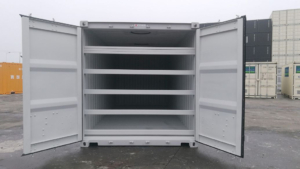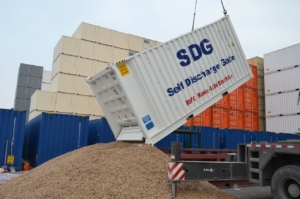Bulk sea containers are essential for transporting large quantities of goods across the globe. Securing and sealing these containers is crucial to ensure that the cargo remains safe and secure during transit. In this article, we will explore how bulk sea containers are secured and sealed for transportation, including the methods and equipment used.

Securing Bulk Sea Containers
Securing it involves ensuring that the cargo is safely stored inside the container and that it remains stable during transport. This is particularly important for bulk cargo, which can shift and move during rough seas, potentially causing damage to the container or the cargo itself. Here are some common methods used to secure bulk sea containers:
- Blocking and Bracing: Blocking and bracing involve using wooden or metal blocks to prevent the cargo from moving within the container. These blocks are placed strategically around the cargo to keep it in place and prevent it from shifting during transit.
- Dunnage Bags: Dunnage bags are inflatable bags that are placed between cargo to fill void spaces and prevent movement. These bags are inflated to the desired pressure, creating a secure barrier that keeps the cargo in place.
- Strapping and Lashing: Straps and lashings are used to secure the cargo to the container walls or floor. These straps are tightened to ensure that the cargo remains stable and does not move during transport.
- Twist Locks: Twist locks are used to secure containers to the ship’s deck or to each other. These locks are twisted into place to create a strong connection that prevents the container from shifting or moving during transit.
- Chocks and Wedges: Chocks and wedges are used to secure heavy or irregularly shaped cargo. These devices are placed under the cargo to prevent it from rolling or sliding during transport.

Sealing Bulk Sea Containers
It is essential to prevent unauthorized access to the cargo and to protect it from theft or tampering. Seals are used to secure the doors of the container and to indicate if the container has been opened during transit. Here are some common types of seals used for bulk sea containers:
- Bolt Seals: Bolt seals are heavy-duty seals that are used to secure the doors of the container. These seals are typically made of metal and are designed to be tamper-evident, meaning they will show signs of tampering if they are removed or replaced.
- Cable Seals: Cable seals are flexible seals that are used to secure the doors of the container. These seals consist of a metal cable that is threaded through the locking mechanism and secured with a locking device. Cable seals are also tamper-evident and will show signs of tampering if they are removed or cut.
- Padlock Seals: Padlock seals are similar to traditional padlocks but are designed to be used as seals for containers. These seals are typically made of metal and are secured with a key or combination lock. Padlock seals are also tamper-evident and will show signs of tampering if they are removed or broken.
- High-Security Seals: High-security seals are specially designed seals that offer enhanced security features, such as unique serial numbers or barcode identification. These seals are often used for high-value cargo or sensitive materials.
- Electronic Seals: Electronic seals, or e-seals, are electronic devices that are used to secure containers. These devices use GPS or RFID technology to track the location of the container and provide real-time monitoring of the cargo. E-seals are often used for high-security applications where real-time tracking is essential.
- Customs Seals: Customs seals are applied by customs officials to indicate that the container has been inspected and cleared for shipment. These seals are usually made of plastic or metal and are tamper-evident to ensure the integrity of the inspection process.
- Inspection and Certification: Before a bulk sea container is sealed, it must undergo inspection to ensure that the cargo is properly secured and that the container is in good condition. Once inspected, the container is certified as safe for transport, and the seals are applied.
- Container Locks: Container locks are used to secure the doors of the container and prevent unauthorized access. These locks are typically made of heavy-duty steel and are designed to withstand tampering and forced entry.
- GPS Tracking: Some bulk sea containers are equipped with GPS tracking devices that allow the cargo owner to track the container’s location in real-time. This added security measure helps ensure that the cargo reaches its destination safely.
- Security Seals: Security seals are used to secure the doors of the container and indicate if the container has been tampered with during transit. These seals are often made of plastic or metal and are designed to break or show signs of tampering if they are removed.
- Container Tracking Systems: In addition to GPS tracking devices, some bulk sea containers are equipped with advanced container tracking systems. These systems use a combination of GPS, cellular, and satellite technology to provide real-time tracking and monitoring of the container’s location, temperature, humidity, and other conditions. This level of monitoring allows for better management of the cargo and helps ensure that it is delivered in optimal condition.
- Temperature Control: For temperature-sensitive cargo, they can be equipped with temperature control systems. These systems allow the temperature inside the container to be maintained within a specific range, ensuring that the cargo remains at the required temperature throughout the journey. Temperature control is crucial for transporting perishable goods such as food, pharmaceuticals, and chemicals.
- Humidity Control: In addition to temperature control, some bulk sea containers are equipped with humidity control systems. These systems help maintain the humidity levels inside the container, which is important for protecting sensitive cargo from moisture damage. Humidity control is particularly important for goods such as electronics, paper products, and textiles.
- Shock and Vibration Monitoring: To protect fragile or sensitive cargo from damage during transport, some are equipped with shock and vibration monitoring systems. These systems detect and record any impacts or vibrations that occur during transit, allowing for quick identification of any potential issues.
- Remote Monitoring and Control: Some advanced bulk sea containers feature remote monitoring and control capabilities. This allows the container’s parameters, such as temperature, humidity, and security status, to be monitored and adjusted remotely, providing greater control over the cargo’s conditions.
Conclusion
Securing and sealing bulk sea containers for transportation is a complex process that involves a combination of physical security measures, advanced technology, and monitoring systems. Cargo owners must carefully plan and pay attention to detail to ensure that their goods are transported safely, securely, and in optimal condition. By implementing a variety of securing methods and seals, they can rest assured that their goods will arrive at their destination safely and intact, regardless of the long distances involved.
CIMC Yang Zhou Base is a leading manufacturer of bulk sea containers and various other standard and special logistics equipment. With years of experience in the industry, it focuses on the design, production and distribution of high-quality innovative products that meet the specific needs of customers.
If you need high-quality and innovative logistics equipment, including refrigerated containers, cold chain equipment, containerized equipment integration, modular buildings, etc., База CIMC Ян Чжоу is your best choice. Welcome inquiries from customers all over the world and look forward to the opportunity to cooperate with you.


